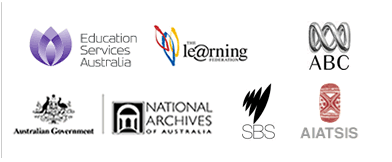Indigenous Film & Television
153 titles - sorted alphabetically or by year prev 1 2 3 next
Film and television titles written and directed by an Indigenous person.
D (continued)

Double Trouble – Episode 7 television program – 2007
Double Trouble has entertaining and likeable characters and boasts an experienced cast. It also wonderfully captures an Indigenous sensibility and humour.

Dugong Dugong documentary – 1980
Depending on the individual viewer’s attitude, scenes of dugong hunting can be exhilarating or disturbing.
F

First Australians – Episode 1, They Have Come to Stay documentary – 2008
The opening episode of this landmark television series explores the first contact, meetings and relationships between the British and the first Australians.

First Australians – Episode 2, Her Will to Survive documentary – 2008
This episode covers the period from 1825–60 and European settlement in Tasmania, told through the stories of Truganini and George Augustus Robinson.

First Australians – Episode 3, Freedom For Our Lifetime documentary – 2008
Episode 3 focuses on the first Australians of Victoria and the lives of Simon Wonga and William Barack.

First Australians – Episode 4, No Other Law documentary – 2008
This episode examines the coming of the telegraph pole and white settlement to Central Australia.

First Australians – Episode 5, Unhealthy Government Experiment documentary – 2008
This episode explores the lives of Jandamarra, an Aboriginal stockman, and Gladys Gillian, an institutionalised half-caste.

First Australians – Episode 6, A Fair Deal for a Dark Race documentary – 2008
Episode 6 of First Australians explores Indigenous history from 1930–67, primarily in the south-eastern regions of Australia.

First Australians – Episode 7, We Are No Longer Shadows documentary – 2008
The final episode of First Australians covers the period 1967–93 and Eddie Mabo’s fight for land rights.

Flat short film – 2002
A short drama about the day in a life of a young teenager. Marnie lives in a housing commission estate and captures Alice Springs through a video camera given to her by her mostly absent father.

Footy The La Perouse Way documentary – 2006
Sydney’s La Perouse had an all-black football team in the 1930s but all nationalities were being welcomed by the 1950s.

The Foundation 1963–1977 documentary – 2002
Excluded from the census until 1967, Indigenous Australians formed The Foundation for Aboriginal Affairs in 1963, to agitate for political and social change.

From Sand to Celluloid – Black Man Down short film – 1996
This short experimental drama offers a spiritual alternative to fighting the system. To overcome injustice, return to your spiritual roots for healing to take place.

From Sand to Celluloid – No Way to Forget short film – 1996
Writer-director Richard J Frankland drew on his experience as a field officer for the Royal Commission into Deaths in Custody to compose this story.

From Sand to Celluloid – Payback short film – 1996
Payback, a black-and-white short about the Western and Indigenous legal systems, is one of Warwick Thornton’s earliest dramatic works.

From Sand to Celluloid – Round Up short film – 1995
Round Up is a lighthearted short drama that deals with the cultural clash between a white stockman and an Indigenous stockman.

From Sand to Celluloid – Two Bob Mermaid short film – 1996
In this visually stunning short film set in the 1950s, a fair-skinned Aboriginal girl gains access to the local swimming pool where Aboriginal people are legally denied access.
G

Green Bush short film – 2005
Warwick Thornton began his film career as a cinematographer and moved into directing and writing. In Green Bush, his visual aesthetic complements his storytelling strengths.

Gulpilil: One Red Blood documentary – 2002
David Gulpilil continues to be a person – culturally and creatively – of incredible artistic significance to Indigenous peoples and Australian society alike.
H

Harry’s War short film – 2000
Richard Frankland, writer and director of the short drama Harry’s War, is from the third generation of Indigenous men to have served in the Australian army.

Here I Am feature film – 2011
A young woman attempts to reconnect with her mother and daughter after her release from prison.
I

Island Fettlers documentary – 2006
In the 1960s, Torres Strait Islander men moved to the Pilbara for work and stayed on. Island Fettlers starkly contrasts two cultures – visually, physically and aurally.
K

Karli Jalangu – Boomerang Today documentary – 2004
The making of the number seven boomerang is not a hurried process, but measured and multifaceted. Every step of the procedure has meaning.
L

Loved Up – Endangered documentary – 2005
While parts of Endangered have a light, Sex and the City feel to them, the undertones are serious and speak of cultural responsibility.

Loved Up – Lore of Love documentary – 2005
This film about people in love is a refreshing break from the usual heavy-handed anthropological treatment of Indigenous subjects.

Loved Up – Our Bush Wedding documentary – 2005
This documentary is about the wedding of artist Gordon Syron and photographer Elaine Pelot-Kitchener. Gordon went to jail for killing a man to protect his family’s country.

Loved Up – The Dream of Love documentary – 2005
Do blackfellas love the same way as everyone else?’ One of four films in this series which engages with themes of Indigenous love, family and identity.

Loved Up – Yellow Fella documentary – 2005
Tommy E Lewis, Indigenous star of the stage and screen, identifies as a 'yellow fella’ – both black and white.
M

Mad Bastards feature film – 2011
TJ returns to the Kimberley region of Western Australia to try and reconnect with his teenage son.

Marn Grook documentary – 1996
'Marn Grook’ is the Indigenous name of a game very similar to AFL. This revealing documentary contends that AFL is in fact derived from Marn Grook.

Merrepen documentary – 2005
Women from the Nauiya community 'are painting our stories and making things’ to practise cultural knowledge and pass on and preserve traditions.

Message Stick – Arafura Pearl television program – 2003
This is a snapshot of the Mills family, a respected family in the Darwin area. Kathleen is an Indigenous Elder, mother of eight, musician and singer.

Message Stick – Babinda Boulders television program – 2005
The story of the Devils Pool, recounted by Yidinji elder Annie Wonga, is an ancient love story. Young men fall victim to a waterhole where the spirit of a woman dwells.

Message Stick – Bill’s Wake television program – 2001
Bill Neidjie, a traditional owner of Kakadu, had a wake while he was alive, rather than waiting until his death, to hear what people wanted to say about him.

Message Stick – Black Olive television program – 2005
As a chef, Mark Olive has developed dishes that use Indigenous knowledge of fauna and flora and food preparation that complements the Australian landscape.

Message Stick – Blacktracker television program – 1996
A tribute to Aboriginal tracker Alexander Riley, a sergeant in the NSW Police Force and a recipient of the King’s Medal in 1943.

Message Stick – Child Artists of Carrolup television program – 2003
This episode provides another perspective on the child removal policies and how the government of the day had specific designs on how half-caste children would occupy a place in society.

Message Stick – Koori Court television program – 2005
The Koori Court in Victoria was set up to reduce high imprisonment rates by combining Aboriginal beliefs with the white legal system.

Message Stick – Kurtal: Snake Spirit television program – 2002
A beautiful story about Kurtal, an ancestor and Dreaming song, and the Elder Spider, whose responsibility it is to perform the dance as well as pass it on.

Message Stick – Macumba: Outside Looking In television program – 2003
Macumba tells the story of Australia’s first Aboriginal radio station, the Central Australian Aboriginal Media Association (CAAMA).

Message Stick – Scotty Martin, Rodeo Boy, Don’t Say Sorry television program – 2005
A story about songman Scotty Martin, who inherited the role of composer of songs, a repository of knowledge passed from generation to generation.

Message Stick – Tent Boxers television program – 2001
A tribute to the Aboriginal men who travelled around Australia in the 1950s and ‘60s with tent-boxing troupes.

Message Stick – The Convincing Ground television program – 2007
The Kilcarer clan rally against a commercial development on a heritage-listed massacre site in Victoria known as the Convincing Ground.

Message Stick – The Long-grassers television program – 2005
An exposé on the homeless Aboriginal people of Darwin, known as 'long-grassers’. Deals with both the compassion and the bigotry they evoke by their mere presence.

Message Stick – Wathaurong Glass television program – 2003
Wathaurong Glass is an initiative that not only creates a new way of expressing Aboriginal art, but also provides a service to the community from which it comes.

Message Stick – Wayne’s World television program – 2005
Indigenous actor and filmmaker Wayne Blair offers insights into his craft and recounts experiences from his career.

Mimi short film – 2002
Warwick Thornton’s satirical short film stars Sophie Lee and Aaron Pedersen and pokes fun at white art collectors who purchase Indigenous art purely for its investment value.

Mimi: An Evening with the Aboriginal Dance Theatre documentary – 1988
NAISDA led to the emergence of the Bangarra Dance Theatre and produced artists such as Christine Anu and Stephen Page.

Minymaku Way: There’s Only One Women’s Council documentary – 2000
Minymaku Way challenges views of Aboriginal community dependence on outside bureaucracy.

Mparntwe Sacred Sites documentary – 2004
This documentary about Mparntwe (Alice Springs) provides a history of the region and the journey of the ancestral beings that gave Mparntwe its form.


